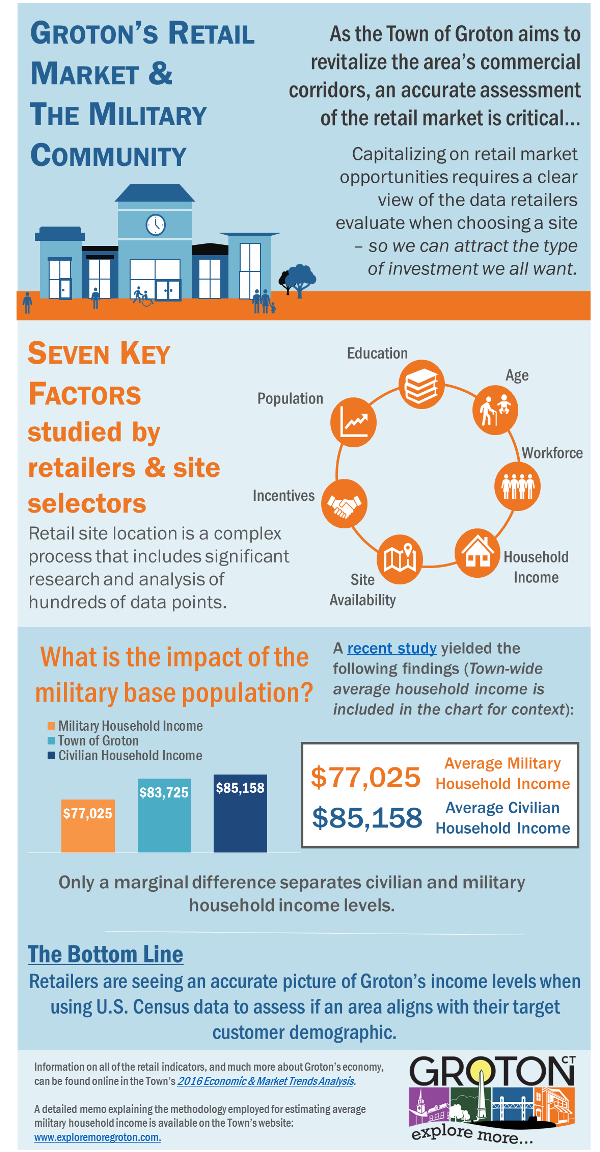Groton's Retail Market and Military Demographics
How do we attract more retailers and service providers to Groton?
Over the past two years, the Town of Groton’s economic development staff and partners have been working to implement projects and initiatives proposed in the 2016 Economic & Market Trends Analysis, which includes a strategy to attract private investment to the town’s commercial corridors. Identifying and capitalizing on retail market opportunities requires the town have a clear understanding of what demographic data and other information retailers and commercial investors consider when determining where to locate. This best positions the Town to attract the type of investment we’d all like to see.
What are retailers looking for?
When determining where to locate, retailers examine resident, workforce, and visitor characteristics of a region to gain an understanding of the potential customer base that fuels business sales. One of the many things retailers look for when making location decisions is the area’s income levels. A question that Groton was asked by potential developers and retailers was “what impact does the military base population have on Groton’s income levels?” We explored this question and found that the difference between military income and civilian income levels in Groton is marginal and has little impact.
So, how do Groton’s income levels stack up?
There are four main income indicators:
- Median Household Income – The value that divides the income distribution in two, with half the households earning above the value and the other half earning below the value.
- Aggregate Household Income – The total of all household incomes in an economy.
- Average Household Income – The aggregate household income divided evenly among the number of households in a region.
- Per Capita Income – The total income in a region divided by the region’s total population, including non-earners.
As of 2016, the average household income of the Town of Groton was $83,724 and projected to rise to $96,732 by 2022. The four income metrics are provided in the following table, benchmarked against New London County and Connecticut.



The Town of Groton falls below New London County and Connecticut in most income metrics for the years 2016 and 2022. Additionally, the Town of Groton’s income metrics are projected to grow at a slower rate compared to the county and state.
Why are income levels in Groton below the surrounding region?
While there is not one single answer, many have wondered if the presence of the Naval Submarine Base New London in Groton is a factor and if, in fact, the income data presented by the Census might be understated – giving potential retailers an inaccurate picture of Groton’s consumer market.
It’s a reasonable question. The military population, including dependents, comprise approximately 27% of the town’s population, with civilians making up the remaining 73%. Military households are an important consumer market segment in Groton and, therefore, it is important to understand how the income in households with military personnel is represented in key data metrics.
With respect to the data, military personnel fall into two categories: personnel living on-base in barracks and personnel living off-base in town. Household income figures provided by the U.S. Census exclude military personnel living in barracks (on-base) because they are considered occupants of group housing, not households. Military personnel living in barracks are primarily 18 to 25-year-olds just out of basic training. They do not receive basic allowance for housing and therefore have significantly lower earnings compared to their off-base counterparts.[1]
There is no publicly-available data on household income for military households in Groton, so we asked our economic development consultants to help shed some light on the impact of the presence of Naval Submarine Base New London in Groton on the town’s demographic and socioeconomic profile. The detailed memo explaining the methodology can be found on the Town’s website here, but the bottom line is there is only a marginal or insignificant difference between military and civilian household income. Conservative estimates put the average military household income at $77,025 and average civilian household income at $85,158. Due to data limitations, this difference is likely overstated because the estimation of military household income excludes any income earned from non-military sources, such as income earned by a civilian spouse.
So, it’s safe to say that retailers relying on income data from the Census are getting an accurate picture of the town’s income levels and can confidently use this data to determine if the area aligns with their targeted demographic.
What Challenges Limit Retail Development in Groton?
Retail site location is not about one factor; it is a complex process that includes significant research and analysis of hundreds of data points. In addition to an area’s income metrics, retailers look at factors including other demographic characteristics and area-specific information to create a shortlist of location options. Other common indicators used by retailers include:
- Total Population – The overall number of people within a certain radius or drive time is a critical indicator for many retailers, since a threshold population density and customer base is key for achieving sales targets.
- Education Levels – For some retailers, the education level of consumers is more important than their incomes. For example, Whole Foods requires a “large number of college-educated residents” living within its stores’ trade areas, while mentioning no minimum income threshold in its site selection guidelines.[2]
- Workforce – The number of jobs, type of jobs, and employment status in a region indicates a potential customer base for retailers. In an area with a high concentration of jobs and employment growth there will be more retail customers with greater spending power. A talented workforce is also important for supporting the business itself.
- Age – Product preferences vary across different age groups. Households with infants and young children will spend a considerable amount on toy stores, day care centers, and baby care items. Compared to other consumer age-groups, the 65 year and older cohort spends a greater portion of their budget at drug stores and less on clothing.
- Number of Homeowners – Purchases on furniture, appliances, hardware, decor, garden and other home goods rise in areas with active housing markets. Homeowners also have different purchasing habits than renters, as they spend considerably more on household fixtures and furnishings.
- Site Availability – Site selection for retail stores is a critical part of ensuring a competitive presence within a market. Certain variables such as visibility, ease of access, cost of construction/rent, access to water and sewer, foot traffic, traffic volumes, and traffic flow are considered when evaluating sites.
- Incentives – Retailers also consider the financial feasibility of investing in different areas. A community’s willingness to partner with the business and offer tax or other incentives to lower development or operational costs can be a significant attractor.
Taking all of the above into consideration, Groton’s economic development team is working to create an attractive environment for retailers to invest in.
Groton’s Economic Development Initiatives
The Town of Groton Planning and Economic Development staff are currently involved in a number of ongoing initiatives aimed at improving Groton’s retail market as well as the community’s “sense of place”. Zoning revisions are underway town-wide with the intent of simplifying business development and investment in Groton’s commercial areas. The town also adopted Tax Increment Financing (TIF) as a mechanism for facilitating investment in high-quality mixed-use developments.
In conjunction with these efforts, town staff members are actively promoting the community as a great place to live and work through both digital and printed marketing materials. This effort is aimed at attracting businesses and new residents with promotional messaging about the local quality of life.
Further, the town staff actively supports local retailers and other small businesses through a suite of resources, including financing options and incentives, networking opportunities, technical assistance, and referrals to business consultation experts.
Questions on this information should be directed to the Town of Groton Office of Planning and Development Services at (860) 446-5995.
[1] Basic Allowance for Housing (BAH) provides uniformed Service members equitable housing compensation based on housing costs in local civilian housing markets within the United States when government quarters are not provided. Source: Defense Travel Management Office: http://www.defensetravel.dod.mil/site/bah.cfm.
[2] https://www.wholefoodsmarket.com/company-info/real-estate






